The Crucial m4 (Micron C400) SSD Review
by Anand Lal Shimpi on March 31, 2011 3:16 AM ESTRandom Read/Write Speed
The four corners of SSD performance are as follows: random read, random write, sequential read and sequential write speed. Random accesses are generally small in size, while sequential accesses tend to be larger and thus we have the four Iometer tests we use in all of our reviews.
Note that we've updated our C300 results on our new Sandy Bridge platform for these Iometer tests. As a result you'll see some higher scores for this drive (mostly with our 6Gbps numbers) for direct comparison to the m4 and other new 6Gbps drives we've tested.
Our first test writes 4KB in a completely random pattern over an 8GB space of the drive to simulate the sort of random access that you'd see on an OS drive (even this is more stressful than a normal desktop user would see). I perform three concurrent IOs and run the test for 3 minutes. The results reported are in average MB/s over the entire time. We use both standard pseudo randomly generated data for each write as well as fully random data to show you both the maximum and minimum performance offered by SandForce based drives in these tests. The average performance of SF drives will likely be somewhere in between the two values for each drive you see in the graphs. For an understanding of why this matters, read our original SandForce article.
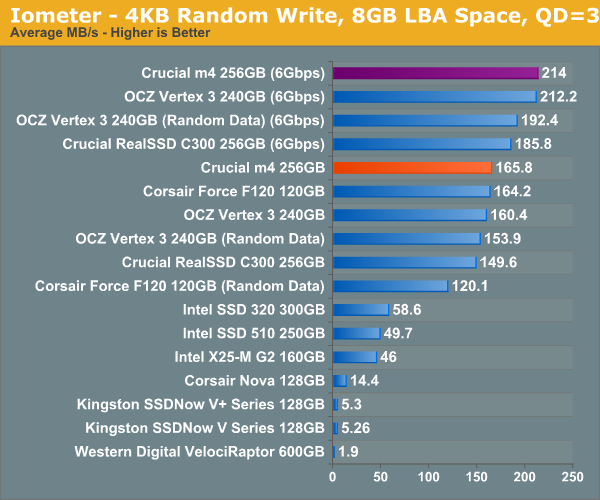
If there's one thing Crucial focused on with the m4 it's random write speeds. The 256GB m4 is our new king of the hill when it comes to random write performance. It's actually faster than a Vertex 3 when writing highly compressible data. It doesn't matter if I run our random write test for 3 minutes or an hour, the performance over 6Gbps is still over 200MB/s.
Let's look at average write latency during this 3 minute run:
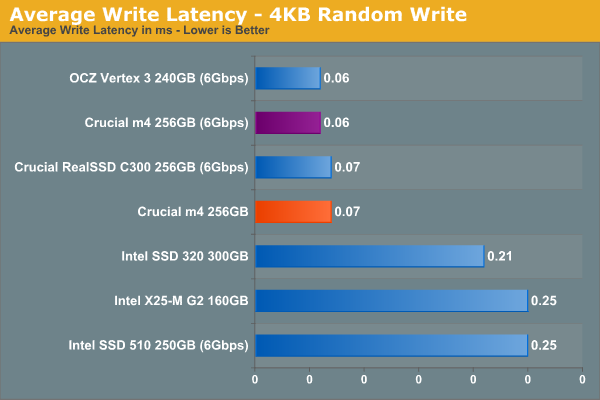
On average it takes Crucial 0.06ms to complete three 4KB writes spread out over an 8GB LBA space. The original C300 was pretty fast here already at 0.07ms—it's clear that these two drives are very closely related. Note that OCZ's Vertex 3 has a similar average latency but it's not actually writing most of the data to NAND—remember this is highly compressible data, most of it never hits NAND.
Now let's look at max latency during this same 3 minute period:
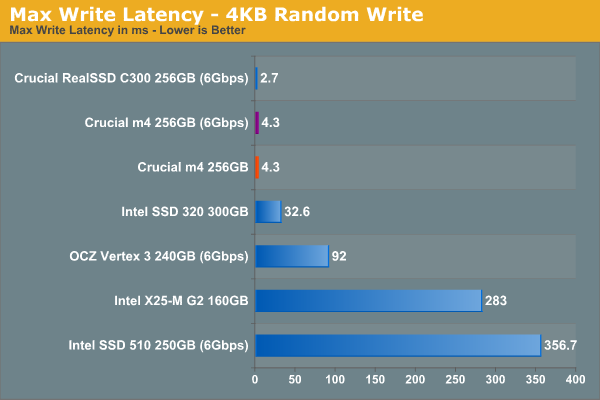
You'll notice a huge increase in max latency compared to average latency, that's because this is when a lot of drives do some real-time garbage collection. If you don't periodically clean up your writes you'll end up increasing max latency significantly. You'll notice that even the Vertex 3 with SandForce's controller has a pretty high max latency in comparison to its average latency. This is where the best controllers do their work. However not all OSes deal with this occasional high latency blip all that well. I've noticed that OS X in particular doesn't handle unexpectedly high write latencies very well, usually resulting in you having to force-quit an application.
Note the extremely low max latency of the m4 here: 4.3ms. Either the m4 is ultra quick at running through its garbage collection routines or it's putting off some of the work until later. I couldn't get a clear answer from Crucial on this one, but I suspect it's the latter. I'm going to break the standard SSD review mold here for a second and take you through our TRIM investigation. Here's what a clean sequential pass looks like on the m4:
Average read speeds are nearing 400MB/s, average write speed is 240MB/s. The fluctuating max write speed indicates some clean up work is being done during the sequential write process. Now let's fill the drive with data, then write randomly across all LBAs at a queue depth of 32 for 20 minutes and run another HDTach pass:
Ugh. This graph looks a lot like what we saw with the C300. Without TRIM the m4 can degrade to a very, very low performance state. Windows 7's Resource Monitor even reported instantaneous write speeds as low as 2MB/s. The good news is the performance curve trends upward: the m4 is trying to clean up its performance. Write sequentially to the drive and its performance should start to recover. The bad news is that Crucial appears to be putting off this garbage collection work a bit too late. Remember that the trick to NAND management is balancing wear leveling with write amplification. Clean blocks too quickly and you burn through program/erase cycles. Clean them too late and you risk high write amplification (and reduced performance). Each controller manufacturer decides the best balance for its SSD. Typically the best controllers do a lot of intelligent write combining and organization early on and delay cleaning as much as possible. The C300 and m4 both appear to push the limits of delayed block cleaning however. Based on the very low max random write latencies from above I'd say that Crucial is likely doing most of the heavy block cleaning during sequential writes and not during random writes. Note that in this tortured state—max write random latencies can reach as high as 1.4 seconds.
Here's a comparison of the same torture test run on Intel's SSD 320:
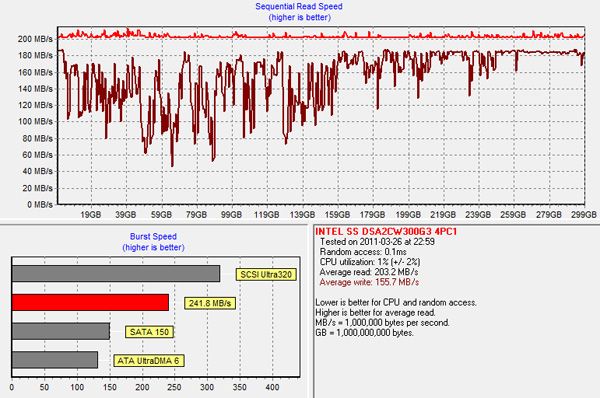
The 320 definitely suffers, just not as bad as the m4. Remember the higher max write latencies from above? I'm guessing that's why. Intel seems to be doing more cleanup along the way.
And just to calm all fears—if we do a full TRIM of the entire drive performance goes back to normal on the m4:
What does all of this mean? It means that it's physically possible for the m4, if hammered with a particularly gruesome workload (or a mostly naughty workload for a longer period of time), to end up in a pretty poor performance state. I had the same complaint about the C300 if you'll remember from last year. If you're running an OS without TRIM support, then the m4 is a definite pass. Even with TRIM enabled and a sufficiently random workload, you'll want to skip the m4 as well.
I suspect for most desktop workloads this worst case scenario won't be a problem and with TRIM the drive's behavior over the long run should be kept in check. Crucial still seems to put off garbage collection longer than most SSDs I've played with, and I'm not sure that's necessarily the best decision.
Forgive the detour, now let's get back to the rest of the data.
Many of you have asked for random write performance at higher queue depths. What I have below is our 4KB random write test performed at a queue depth of 32 instead of 3. While the vast majority of desktop usage models experience queue depths of 0—5, higher depths are possible in heavy I/O (and multi-user) workloads:
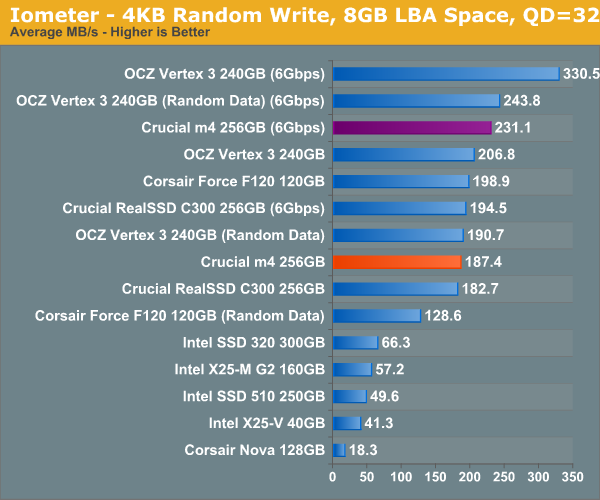
High queue depth 4KB random write numbers continue to be very impressive, although here the Vertex 3 actually jumps ahead of the m4.
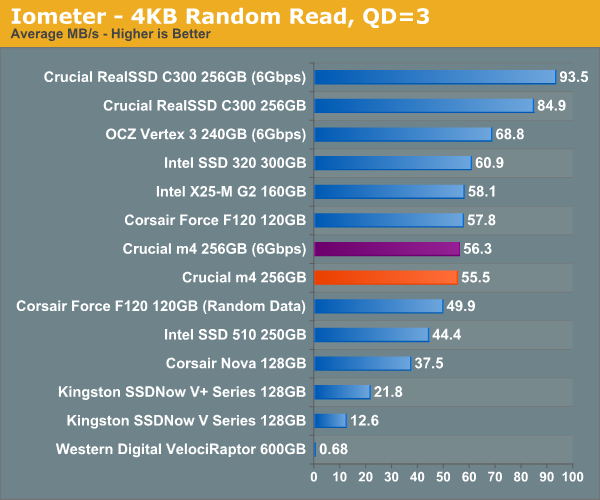
Random read performance is actually lower than on the C300. Crucial indicated that it reduced random read performance in favor of increasing sequential read performance on the m4. We'll see what this does to real world performance shortly.


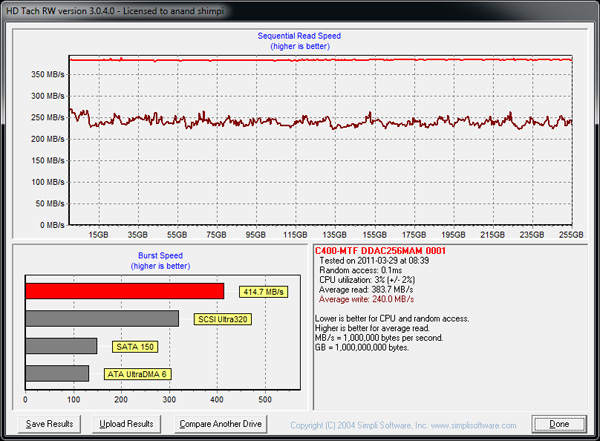
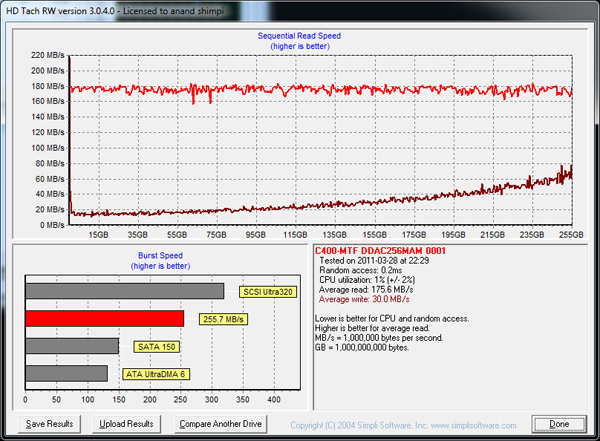
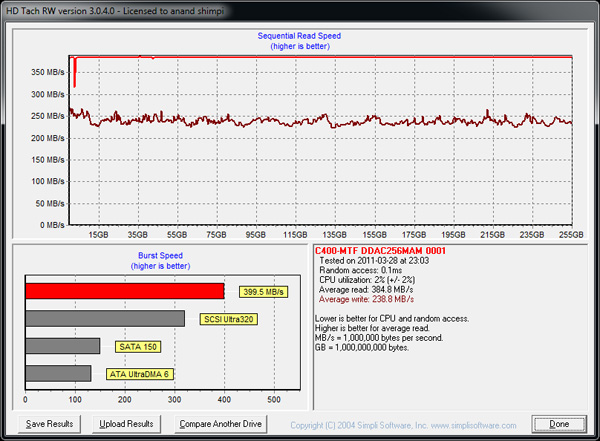








103 Comments
View All Comments
7Enigma - Friday, April 1, 2011 - link
No. You do not. The TRIM command will either run at a set interval or you can do it manually depending on the drive maker (INTEL for instance has a Toolbox that I use once a week or so), and this will return the drive to near-new performance. It's only OS' and drives that do not support TRIM that a complete format (or another method such as copying a large amount of data to the drive and erasing) would be required for this.eamon - Sunday, April 3, 2011 - link
You don't even need that - windows will issue the trim command automatically after a file delete if a block becomes available. You don't need any special driver or special tool; normal use will trigger trims on win7.danbi - Wednesday, April 6, 2011 - link
The typical "OS drive" is "write rarely, read many times". There might be occasional writes to the OS drive, in form of log files, new drivers etc. You rarely, if ever delete files from the "OS drive". Perhaps only when you uninstall software.How would TRIM (supporting OS) ever help in such scenario?
One thing I miss form the "TRIM performance" is what happens when you overwrite already existing files -- pretty common task, by the way.
Another thing, performance with COW file systems, such as ZFS. These file systems will never overwrite data (except metadata) and most of the time writes will be "sequential".
By the way, another missing performance metric is what each drive considers "sequential write". How much KB data in one I/O operations sequential? Is this common with all drives?
faster - Thursday, March 31, 2011 - link
The egg has the RevoDrive 240 GB for $570. The 3rd gen Intel drive is $614 at 250 GB. The new M4 drive is $599?. Price competition in this price point would warrant a comparison in performance. I would like to see the X2 skew the chart to illustrate performance per dollar invested. I understand that the X2 is a PCIE self contained RAID card, but it is a bootable card making it a hard drive competitor. No matter how you feel about it, it would be an interesting comparison from an economic viewpoint.flexcore - Friday, April 1, 2011 - link
Good review! The problem is there are so many different versions of each drive. They change performance characteristics as the size of the drive changes. (Not even getting into OCZ's recent crimes against consumers)I like what MilwaukeeMike brought up about different types of users and how different drives seem to be suited better for different usage patterns. As a AMD user I would also appreciate a review on how these drives perform on AMD platform vs Intel. Then we have TRIM. This is becoming more and more of the normal operational mode, but not always, and what about in RAID configuration.
WOW, these are not the only questions that I continually have been hearing asked on forums around the web. This is a lot of information and work but, you are a leader in SSD reviews. I applaud your efforts ANAND and want to thank you for doing the work you do. I think you are heading in the right direction with your own storage benchmarks, but thats only part of what consumers need. More real world usage to be able discern the actual advances from each new generatin of drive is important also. I look forward to reading more of your insights into where we are and where we are heading with SSD technology.
7Enigma - Friday, April 1, 2011 - link
What we need is some understanding of what is really needed by a SSD. We have all these different benchmarks that are combining IMO way too many tasks at once that a human just cannot perform. Yes it's great to tease out a pretty graph, but what I think most of us want to really see is what is the real-world difference.Things like the Gaming benchmark where there is practically NO difference between current and last-gen drives (hell even the G2 is pretty close) are very important to me so I don't get the upgrade bug for something I really have no major benefit from. Vantage as well.
Anand's said it for a while but there is a huge difference between SSD and mechanical drive, once you upgrade to SSD, however, the improvements for most human workloads (ie non benchmarks) is slim.
I'd love a mini article that would track 4-5 different people's usage models: gamer, web surfer/facebook/iTunes average joe, encoder, and whatever other major "type" of person that frequents Anandtech (it should be biased towards the readership IMO), and then create a benchmark based on that.
We don't need 24 programs opening simultaneously while downloading a torrent and doing a virus scan. What we do need to see is if there is any tangible benefit to 6Gbps SATA over 3 in normal daily use and G1 to Vertex3. If not the numbers are great and if buying a SSD for the first time or building a system OK, but the need to upgrade from an existing SSD is just not there.
Great article btw!
X-Nemesis - Friday, April 1, 2011 - link
This is what I think as well...it does not seem like there is really any real world benefit to upgrade an older generation SSD to the new 6Gbps offerings. The only reason to upgrade would be size at a much cheaper price point.Nicolas Pillot - Friday, April 1, 2011 - link
I'm quite new to the field, and looking at the charts i have a plainly simple (but stupid ?) question : how is it that the read speed are lower than the write speed ?!7Enigma - Friday, April 1, 2011 - link
Make sure you are comparing apples to apples. Sequential read/write will be much higher then random read/write so if you are comparing a random read to a sequential write you will see a discrepancy.iwodo - Friday, April 1, 2011 - link
Just thought Anand you should compare all the 40 - 80GB Range SSD. Since it is very likely that we buy the lower capacity drive then the expensive but also slightly faster SSD.